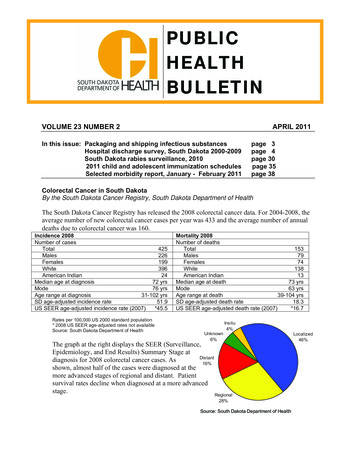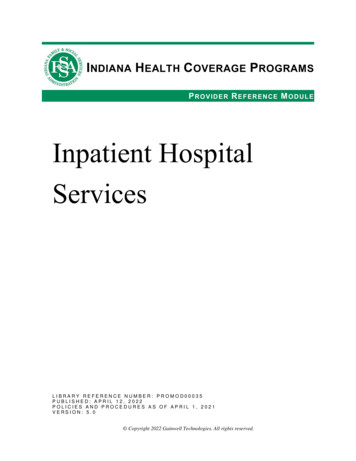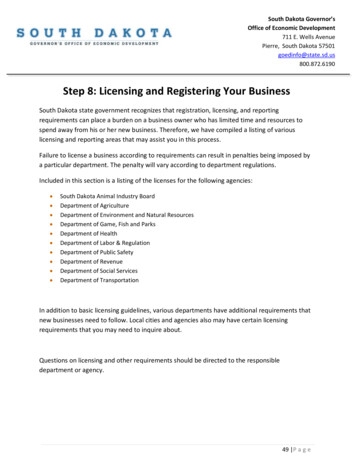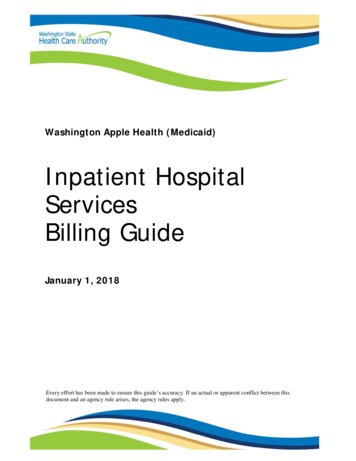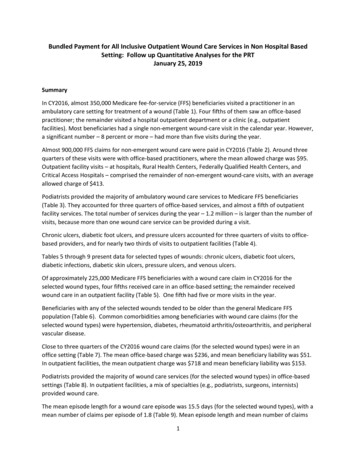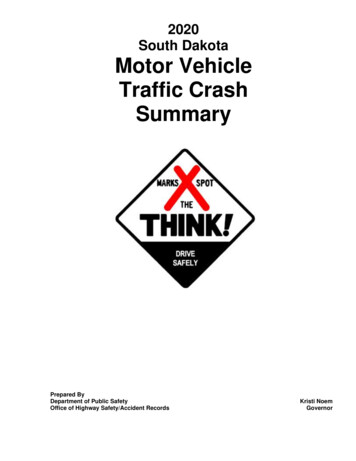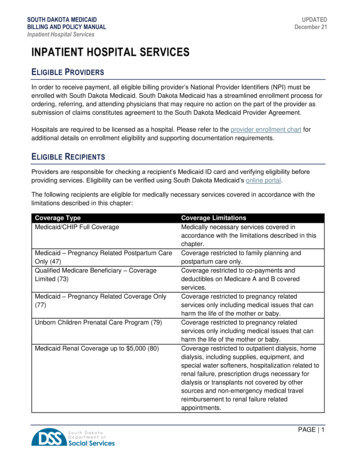
Transcription
SOUTH DAKOTA MEDICAIDBILLING AND POLICY MANUALInpatient Hospital ServicesUPDATEDDecember 21INPATIENT HOSPITAL SERVICESELIGIBLE P ROVIDERSIn order to receive payment, all eligible billing provider’s National Provider Identifiers (NPI) must beenrolled with South Dakota Medicaid. South Dakota Medicaid has a streamlined enrollment process forordering, referring, and attending physicians that may require no action on the part of the provider assubmission of claims constitutes agreement to the South Dakota Medicaid Provider Agreement.Hospitals are required to be licensed as a hospital. Please refer to the provider enrollment chart foradditional details on enrollment eligibility and supporting documentation requirements.ELIGIBLE R ECIPIENTSProviders are responsible for checking a recipient’s Medicaid ID card and verifying eligibility beforeproviding services. Eligibility can be verified using South Dakota Medicaid’s online portal.The following recipients are eligible for medically necessary services covered in accordance with thelimitations described in this chapter:Coverage TypeMedicaid/CHIP Full CoverageMedicaid – Pregnancy Related Postpartum CareOnly (47)Qualified Medicare Beneficiary – CoverageLimited (73)Medicaid – Pregnancy Related Coverage Only(77)Unborn Children Prenatal Care Program (79)Medicaid Renal Coverage up to 5,000 (80)Coverage LimitationsMedically necessary services covered inaccordance with the limitations described in thischapter.Coverage restricted to family planning andpostpartum care only.Coverage restricted to co-payments anddeductibles on Medicare A and B coveredservices.Coverage restricted to pregnancy relatedservices only including medical issues that canharm the life of the mother or baby.Coverage restricted to pregnancy relatedservices only including medical issues that canharm the life of the mother or baby.Coverage restricted to outpatient dialysis, homedialysis, including supplies, equipment, andspecial water softeners, hospitalization related torenal failure, prescription drugs necessary fordialysis or transplants not covered by othersources and non-emergency medical travelreimbursement to renal failure relatedappointments.PAGE 1
SOUTH DAKOTA MEDICAIDBILLING AND POLICY MANUALInpatient Hospital ServicesUPDATEDDecember 21Refer to the Recipient Eligibility manual for additional information regarding eligibility includinginformation regarding limited coverage aid categories.Inpatient Coverage for InmatesInmates of a public institution who are held involuntarily may be enrolled in Medicaid, but may notreceive Medicaid covered services per 42 CFR 435.1010. However, inpatient services may be coveredif the service is covered by South Dakota Medicaid and provided by an enrolled provider in anappropriate setting for a period greater than 24 hours.COVERED SERVICES AND LIMITSGeneral Coverage PrinciplesProviders should refer to the General Coverage Principles manual for basic coverage requirements allservices must meet. These coverage requirements include: The provider must be properly enrolled; Services must be medically necessary; The recipient must be eligible; and If applicable, the service must be prior authorized.The manual also includes non-discrimination requirements providers must abide by.Inpatient Hospital CoverageThe following inpatient hospital services are covered under South Dakota Medicaid: Semiprivate room accommodations and board. Private rooms are covered when justified by astatement of medical necessity from the attending physician or other licensed practitioner; Regular nursing services routinely furnished by a hospital; Supplies, such as splints and casts, and the use of appliances and equipment, such aswheelchairs, crutches, and prostheses; Diagnostic services; Therapeutic services; Operating and delivery rooms; Drugs and biologicals ordinarily furnished by the hospital; Medical social services; Services of hospital residents and interns who are in approved training programs; Dialysis treatments; Services of hospital-based physicians or other licensed practitioners; Sterilizations authorized under ARSD 67:16:02:09 and in accordance with the Sterilizationmanual; and Hysterectomy authorized under 42 CFR 441.250 to 441.259 and the Hysterectomy manual.Inpatient and Outpatient StatusPAGE 2
SOUTH DAKOTA MEDICAIDBILLING AND POLICY MANUALInpatient Hospital ServicesUPDATEDDecember 21Inpatient status occurs when a recipient has been admitted to a hospital on the recommendation of aphysician or a dentist and the stay in the hospital is 24 hours or more. The following are considered aninpatient stay even if the length of stay is less than 24 hours: Delivery of an infant or newborn care; Death of an inpatient who meets inpatient criteria at the time of admission; and Inpatient that needs to be transferred to a higher level of care.Outpatient services are professional services provided to a recipient at a participating hospital, but theservices provided to the recipient along with any room and board are for a period of less than 24 hours.A “transfer to detox” service is considered an outpatient service. Observation services are outpatienthospital services.Counting Inpatient DaysThe number of days of care for inpatient hospital care services is always in units of full days. A daybegins at midnight and ends 24 hours later. The midnight-to-midnight method is to be used in countingdays of care for South Dakota Medicaid reporting purposes even if the hospital uses a differentdefinition of day for statistical or other purposes.A part of a day, including the day of admission and day on which a recipient returns from leave ofabsence, counts as a full day. However, the day of discharge, death, or a day on which a recipientbegins a leave of absence is not counted as a day unless discharge or death occur on the day ofadmission. If admission and discharge or death occur on the same day, the day is considered a day ofadmission and counts as one inpatient day. Charges for ancillary services on the day of discharge ordeath or the day on which a patient begins a leave of absence are covered.Late DischargeIf a recipient chooses to continue to occupy hospital accommodations beyond the checkout time forpersonal reasons, the hospital may charge the recipient for the continued stay. Such a stay beyond thecheckout time, for the comfort or convenience of the recipient, is not covered by South DakotaMedicaid. However, the hospital must notify the recipient that they will be charged for the continuedstay in accordance with the Billing a Recipient Manual.If the recipient’s medical condition is the cause of the stay past the checkout time (e.g., the recipientneeds further services, is bedridden and awaiting transportation to a skilled nursing facility, or dies inthe hospital), the stay beyond the discharge hour is covered under the program and the hospital maynot charge the recipient.Outpatient Services Incurred Prior to an Inpatient StayOutpatient services incurred within three days immediately preceding the inpatient stay are included inthe inpatient reimbursement unless the outpatient service is not related to the inpatient stay. Thisprovision applies only if the facilities providing the inpatient and outpatient services are owned by thesame entity.PAGE 3
SOUTH DAKOTA MEDICAIDBILLING AND POLICY MANUALInpatient Hospital ServicesUPDATEDDecember 21Hospital Readmission within 72 HoursA readmission within 72 hours from time of discharge to the same hospital for a the same or a relateddiagnosis is considered a continuation of the prior admission for payment purposes. Readmission orreturn to a hospital following a leave of absence, regardless of length, is not considered a separateadmission.Inpatient Psychiatric Hospital ServicesFor inpatient psychiatric hospital services, including county mental health holds, the recipient must beadmitted to the hospital and the stay must be for a period of 24 hours or longer. All inpatient psychiatrichospital services must be prior authorized. Tribal mental health holds are covered pursuant to White v.Califano and 42 CFR 136.61.Medical DetoxificationSouth Dakota Medicaid covers inpatient hospitalization for medical detoxification requiring acutemedical intervention. Inpatient hospitalization for chemical dependency treatment is not a coveredservice and may not be billed to Medicaid.Prior Authorization for Hospital ServicesServices requiring prior authorization are listed on our website. If a prior authorization is required it isthe responsibility of the attending physician, other licensed practitioner, or the physician or otherlicensed practitioner representative, or the hospital to obtain prior authorization from South DakotaMedicaid or our authorized representative prior to services being provided. If a service is providedwithout an authorization the claim may be denied.Long-Term Care Acute Hospital UnitsPrior authorization is required before admission to a long-term care acute hospital unit. Admissions arelimited to transfers from a general acute care hospital and must be more cost effective than if the entirelength of stay had been in the general, acute care hospital.An individual's admission to a long-term care hospital unit is a covered service if the hospital receivedauthorization for the admission under ARSD 67:16:40:04 and it is determined determines that thefollowing requirements are met: The individual is medically stable; The individual has potential for functional gains within two weeks; The individual is able to participate in rehabilitation therapies and can demonstrate gains infunctional abilities; The medical complications cause a significant decline in physical function; and There is no alternative course of treatment setting available for the recipient requesting theservice which is more conservative or substantially less costly.Medically Complex ProgramPrior authorization is required before admitting a child to a medically complex program. The generalprior authorization form is to be used by providers as written documentation to support medicalPAGE 4
SOUTH DAKOTA MEDICAIDBILLING AND POLICY MANUALInpatient Hospital ServicesUPDATEDDecember 21necessity and must be completed and maintained in the patient’s medical record prior to submitting aclaim to South Dakota Medicaid.Admission to a medically complex program is a covered service if the following criteria are met: Medical documentation substantiates that the service is medically necessary. Medicaldocumentation includes a diagnosis, a complete medical history, copies of progress notes fromphysicians or other professionals providing care or services, laboratory tests, x-rays, physicianorders and a treatment plan outlining the needed care, and any other documentation which maybe necessary to determine medical necessity for the child's admission; Home health care is not a viable option as determined by the department based on the child'smedical needs, the availability of home health services, and cost effectiveness; The facility has notified the child's school district that the child has been referred to the facilityfor services and may be in need of an educational program; The cost of care does not exceed the cost of care in the child's home; and Professional nursing services are necessary on a 24-hour basis and the child requires at leasttwo of the following services:o Intravenous medications more than twice a day which must be administered by aregistered nurse;o Drug therapy stabilization which requires skilled monitoring on a 24-hour basis;o Nutritional therapy during an unstable period;o Alternative nutritional feeding, such as nasogastric or gastrostomy feeding, during anunstable period;o Tracheostomy care during an unstable period;o Colostomy or ileostomy care during an unstable period;o Skilled skin care and monitoring for the treatment of a decubitus ulcer;o Monitoring of oxygen saturation when oxygen is being administered;o Skilled nursing observation and assessment following casting or surgeries;o Direct paraprofessional care for more than eight hours a day which is supervised by amedical professional;o Peritoneal dialysis during an unstable period;o Infectious disease care during an unstable period;o Use of a ventilator during an unstable period; oro Professional monitoring to manage end stage disease process.For purposes of this section, an unstable period is that period of time necessary for a child to return to amedically stable state following a disease process, illness, or surgery.Neonatal UnitsAll stays must be prior authorized by South Dakota Medicaid. Please send the admissions history andphysical within one business day of completion and weekly progress reports. South Dakota Medicaidwill only accept NICU/ICN authorization request for infants who are currently enrolled in South DakotaMedicaid. No authorization request will be processed without an attached South Dakota Medicaid IDnumber. If infants are hospitalized for a period of less than 30 days, please submit and NICU/ICNhistory and physical and a discharge summary with your request for authorization. For infants whoPAGE 5
SOUTH DAKOTA MEDICAIDBILLING AND POLICY MANUALInpatient Hospital ServicesUPDATEDDecember 21require stays in excess of 30 days, please provide monthly progress notes and final dischargesummary.To be prior authorized a neonatologist must order the admission, there must be a comprehensivehistory and physical that addresses the need for the admission, the condition must require continuouscardiopulmonary monitoring, the condition must require monitoring of complete vital signs at a minimumof once every four hours, and the infant must have at least one of the following conditions: Abnormal vital signs, hematology, or chemistry to cause endangerment; Congenital abnormalities causing functional impairment Pulmonary distress; Metabolic distress; Cardiac distress; Neurological distress; Gastrointestinal abnormalities; Sepsis; Prematurity of significant intrauterine growth retardation; or Any condition which requires surgery within 48 hours after birth.Continued stay in neonatal intensive care unit is a covered service if at least one of the aboveconditions continues to exist.An infant's care in a neonatal intensive care unit becomes a noncovered service if the infant meets allof the following criteria: Vital signs and medical conditions, including apnea and bradycardia, are stable or resolved andthe infant no longer requires intensive care; The newborn could go home or to another hospital unit; and The newborn is being nourished and has consistent weight and growth.Psychiatric UnitsIn-state in-patient hospital psychiatric services are prior authorized by the South Dakota Foundation(SDMFC) for Medical Care. South Dakota Medicaid prior authorizes out-of-state psychiatric services.An individual's psychiatric care is a covered service if the hospital received authorization for theadmission under ARSD 67:16:40:04 and the following conditions are met: A physician completed a medical assessment of the individual and had at least a telephoneconsultation with a psychiatrist. The psychiatric consultation or diagnosis must include atreatable mental health condition. An admission is not allowed on the basis of a previousdiagnosis if symptoms associated with the diagnosis are not active at the time of the admission; Outpatient services have failed or are not available in the community, or available services donot meet the treatment needs of the individual; Treatment of the individual's psychiatric condition requires services on an inpatient basis underthe direction of a physician, and there is an expectation that the individual will improve withpsychiatric treatment of less than ten days;PAGE 6
SOUTH DAKOTA MEDICAIDBILLING AND POLICY MANUALInpatient Hospital Services UPDATEDDecember 21Inpatient services are expected to improve the individual's condition or prevent furtherregression so that the inpatient services will no longer be needed; andThe individual meets one of the following criteria:o Exhibits behavior which supports a reasonable expectation that the individual will inflictserious physical injury upon himself or others in the very near future, including a recentlyexpressed threat which, if considered in light of its context or in light of the individual'srecent previous acts, is substantially supportive of an expectation that the threat will becarried out;o Exhibits psychotic behavior with hallucinations or delusions;o Is admitted under the provisions of SDCL 27A-10-1 and 27A-10-2 for a 24- hour hold foran evaluation; oro Experiences reactions or intolerances to medications which cannot be managed in anoutpatient or medical floor setting.Within 24 hours after an individual is admitted for inpatient psychiatric care, the hospital must have apsychiatrist complete a psychiatric evaluation of the individual. The evaluation must be included in theindividual's medical record.An individual's continuous and uninterrupted stay in inpatient psychiatric care is a covered service ifSDMFC determines that the following criteria are met: The individual continues to be a danger to self or others and is not able to function or utilizeoutpatient care, as reflected in the physician's, nurse's, or auxiliary staff's notes; The individual is complying with the recommendations made through the care conferences; and The individual's daily progress notes show improvement towards the goal of discharge.An individual's psychiatric care becomes a non-covered service when the SDMFC determines that theconditions of ARSD 67:16:40:07 are no longer met.Rehabilitation UnitsSouth Dakota Medicaid prior authorizes in-state and out-of-state rehabilitation services. An individual'sadmission to a rehabilitation unit is a covered service if the hospital received authorization for theadmission under ARSD 67:16:40:04 and South Dakota Medicaid determines that the following criteriaare met: The individual's previous medical condition was functional; The individual is capable of weekly improvement in the activities of daily living; The individual's primary medical condition is stable; and The individual is able to participate in rehabilitation therapies and can demonstrate gains infunctional abilities.An individual's continued stay in a rehabilitation unit is a covered service under this chapter if theindividual demonstrates weekly improvement in becoming independent in the activities of daily livingand is complying with the recommendations made through the care conference.PAGE 7
SOUTH DAKOTA MEDICAIDBILLING AND POLICY MANUALInpatient Hospital ServicesUPDATEDDecember 21An individual's care in a rehabilitation unit becomes a non-covered service if South Dakota Medicaiddetermines that the individual meets any of the following criteria: The individual has reached potential in the current setting; The individual is functional; The individual's condition is stable to the point of receiving outpatient care or care in analternative setting; or The individual is not complying with the recommendations made through the care conference.Inpatient Hospitalization Six Day NotificationAll in-state hospitals, hospitals within 50 miles of the South Dakota border, and hospitals in Bismarck,North Dakota must submit a notification to South Dakota Medicaid for recipients on day six of an acuteinpatient hospital admission. This notification is required even if South Dakota Medicaid is thesecondary or tertiary payer. The requirement applies to all Medicaid recipients including recipientsparticipating in a Medicare savings program, HCBS waiver, SSI, long term care, and CHIP. Upondischarge the provider must update the form with the pertinent discharge information. Inpatient hospitalstays may be subject to payment reduction if they are not properly reported.Emergency ServicesPlease refer to the Emergency Services manual for information regarding services provided in anemergency department.NON -C OVERED SERVICESGeneral Non-Covered ServicesProviders should refer to ARSD 67:16:01:08 or the General Coverage Principles manual for a generallist of services that are not covered by South Dakota Medicaid.Inpatient Hospital Non-Covered ServicesIn addition to other services not specifically listed as a covered inpatient service, the following inpatienthospital services are not covered by South Dakota Medicaid: Physician’s services other than services by residents and interns in training. Physician servicesshould be billed separately using the guidance on our website; Private duty nursing services; Personal comfort or convenience items; Organ transplants except as authorized under the provisions of ARSD Ch. 67:16:31 and inaccordance with the Surgical Services manual; Custodial care; Autopsies; Chemical dependency or chemical abuse treatment services. For information regardingcoverage of services provided by a substance use disorder treatment agency please refer to theSubstance Use Disorder Agency Services manual; Psychiatric stays for a period of less than 24 hours including county mental health holds that areless than 24 hours;PAGE 8
SOUTH DAKOTA MEDICAIDBILLING AND POLICY MANUALInpatient Hospital Services UPDATEDDecember 21Services provided by freestanding psychiatric hospitals;Health Care Acquired Conditions as defined in Section 2702 of the Patient Protection andAffordable Care Act; andOther Provider Preventable Conditions in any Medicaid care settings where these events occuras defined in Section 2702 of the Patient Protection and Affordable Care Act.DOCUMENTATION REQUIREMENTSGeneral RequirementsProviders must keep legible medical and financial records that fully justify and disclose the extent ofservices provided and billed to South Dakota Medicaid. These records must be retained for at least 6years after the last date a claim was paid or denied. Please refer to the Documentation and RecordKeeping manual for additional requirements.REIMBURSEMENT AND CLAIM INSTRUCTIONSTimely FilingSouth Dakota Medicaid must receive a provider's completed claim form within 6 months following themonth the service was provided. Requests for reconsiderations will only be considered if they arereceived within the timely filing period or within 3 months of the date a claim was denied. The time limitmay be waived or extended by South Dakota Medicaid in certain circumstances. Providers should referto the General Claim Guidance manual for additional information.Third-Party LiabilityMedicaid recipients may have one or more additional source of coverage for health services. SouthDakota Medicaid is generally the payer of last resort, meaning Medicaid only pays for a service if thereare no other liable third-party payers. Providers must pursue the availability of third-party paymentsources and should use the Medicare Crossover or Third-Party Liability billing instructions whenapplicable. Providers should refer to the General Claim Guidance manual for additional information.Medicare ExhaustedWhen Medicare denies an inpatient claim due to Medicare benefits being exhausted, Medicaidbecomes the primary payer for recipients that also have full coverage Medicaid. This does not apply toindividuals with QMB coverage. Covered services are reimbursed according to the hospital’s applicablereimbursement methodology.DRG ReimbursementReimbursement for services provided to a patient admitted to an in-state acute care hospital that hadmore than 30 Medicaid discharges during the hospital's fiscal year ending June 30, 1997 is based onthe Diagnostic Related Group (DRG) weight factors, the hospital's target amount, per diem capital, andeducation costs per day. A list of the DRGs and their associated weight factors is available on our Listof Diagnostic Related Groups fee schedule on our schedule website. There is not cost settlement forinstate DRG hospitals unless an amount is due the South Dakota Medicaid program.PAGE 9
SOUTH DAKOTA MEDICAIDBILLING AND POLICY MANUALInpatient Hospital ServicesUPDATEDDecember 21Services Covered by DRGServices must meet South Dakota Medicaid’s coverage requirements for inpatient services. Forservices that meet these requirements, South Dakota Medicaid has adopted Medicare’s definition ofinpatient hospital services covered by DRG payment. Please refer to the Medicare Claims ProcessingManual, Chapter 3 – Inpatient Hospital Billing for guidance.DRG Payment CalculationA DRG Payment is calculated using the following formula:(Hospital Target Amount X DRG Weight) (Daily Capital and Education Cost X Length of RecipientStay) Payment AmountCost OutlierIn addition to the regular DRG reimbursement, South Dakota Medicaid will pay an additional amount ifthe claim meets the definition of a cost outlier. A “cost outlier” is a hospital claim with 70 percent of thebilled charges (excluding non-covered charges) exceeding the greater of 1.5 times the standard DRGpayment amount or the outlier threshold listed on the Outlier Threshold fee schedule on our website.The amount of the cost outlier payment is equal to 90 percent of the cost outlier.Claims considered to be cost outliers and containing revenue code 275 or 278 will be reimbursedaccording to the following guidelines: Reimbursement for aggregate charges in excess of 50,000 associated with revenue code 275or 278 is limited to the provider's actual cost plus 10 percent; and Aggregate charges for revenue code 275 or 278 in excess of 50,000 shall be removed fromthe calculation of the claim, and charges associated with the remainder of the claim shall bereimbursed according to the standard logic for reimbursing DRG claims.Providers must submit a copy of the supplier’s invoice for items associated with revenue code 275 and278.Patient Transfer, Referral, or Discharge - Medically NecessaryIf a patient is transferred, referred, or discharged to another hospital or another type of special carefacility and the transfer, referral, or discharge is medically necessary or if a patient leaves the hospitalagainst medical advice, reimbursement is on a per diem basis. The rate of reimbursement isdetermined using the following steps: Multiply the hospital's target amount by the weight factor of the DRG assigned to the claim. Divide the result by the geometric mean length of stay. Multiply the result by the number of days the individual was an inpatient. Add the hospital's daily capital and education cost.The amount paid may not exceed 100 percent of the allowed DRG reimbursement.Patient Transfer – Not Medically NecessaryIf a patient is transferred between hospitals and the transfer is not medically necessary, the totalreimbursement for the combined care may not exceed 100 percent of the payment the transferringhospital would have received had all the needed services been provided by the transferring hospital.PAGE 10
SOUTH DAKOTA MEDICAIDBILLING AND POLICY MANUALInpatient Hospital ServicesUPDATEDDecember 21The rate of reimbursement for the receiving hospital is the difference between the transferring hospital'spayment and the payment the transferring hospital would have received had the entire episode of carebeen provided by the transferring hospital. If the transferring hospital is eligible for 100 percent of thepayment, no payment is made to the receiving hospital.The cost of transporting the patient between hospitals is included in the maximum DRG reimbursementand is not payable as a separate transportation service under the provisions of ARSD Ch. 67:16:25.This section does not apply if the transfer is from an out-of-state hospital to a South Dakota hospital aslong as the hospital care is medically necessary.Medicare CrossoverIf the amount paid by Medicare for a Medicare crossover claim is greater than the amount SouthDakota Medicaid would pay based on the DRG payment calculation, South Dakota Medicaid considersthe claim to be paid in full and no additional payment will be made. If the amount paid by Medicare isless than the calculated DRG amount, South Dakota Medicaid will reimburse the difference betweenthe two payment amounts up to the Medicare inpatient deductible.DRG Exempt Hospital Units ReimbursementIn-state freestanding rehabilitation hospitals, public health service hospitals, acute hospital with lessthan 30 Medicaid discharges during their fiscal year ending after June 30, 1996, and before July 1,1997, are exempt from Diagnostic Related Group (DRG) reimbursement provisions.Reimbursement for in-state DRG-exempt hospitals and units is based on reasonable and allowablecosts with the following exceptions: Costs associated with non-hospital certified registered nurse anesthetists that relate to exemptunits of hospital are included as allowable costs; and Capital and education costs incurred for inpatient services are included as allowable costs.Exempt Neonatal Intensive Care Units (NICU)South Dakota Medicaid may exempt in-state intensive care nursery units from DRG reimbursements byrequest of the hospital if all costs and statistics relating to the operation of the unit are identifiable and ifthe unit meets the following criteria: Provides care for infants under 750 grams; Provides care for infants on ventilators; Provides major surgery for newborns; Has 24-hour coverage by a neonatologist; and Has a maternal neonatology transport team.When an infant is transferred between a DRG-reimbursed hospital unit and a DRG-exempt intensivecare nursery unit (NICU) within the same hospital, the total reimbursement for the combined care in theunits may not exceed the amount payable had all necessary services been delivered in the NICU.PAGE 11
SOUTH DAKOTA MEDICAIDBILLING AND POLICY MANUALInpatient Hospital ServicesUPDATEDDecember 21Exempt Psychiatric UnitsSouth Dakota Medicaid may exempt a psychiatric unit and a rehabilitation unit from DRGreimbursement by request of the hospi
South Dakota Medicaid covers inpatient hospitalization for medical detoxification requiring acute medical intervention. Inpatient hospitalization for chemical dependency treatment is not a covered service and may not be billed to Medicaid. Prior Authorization for Hospital Services

